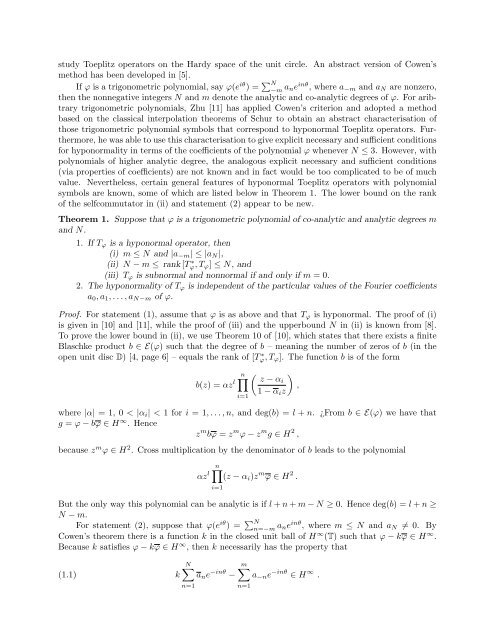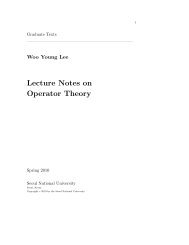ON HYPONORMAL TOEPLITZ OPERATORS WITH POLYNOMIAL ...
ON HYPONORMAL TOEPLITZ OPERATORS WITH POLYNOMIAL ...
ON HYPONORMAL TOEPLITZ OPERATORS WITH POLYNOMIAL ...
You also want an ePaper? Increase the reach of your titles
YUMPU automatically turns print PDFs into web optimized ePapers that Google loves.
study Toeplitz operators on the Hardy space of the unit circle. An abstract version of Cowen’s<br />
method has been developed in [5].<br />
If ϕ is a trigonometric polynomial, say ϕ(e iθ ) = ∑ N<br />
−m a ne inθ , where a −m and a N are nonzero,<br />
then the nonnegative integers N and m denote the analytic and co-analytic degrees of ϕ. For aribtrary<br />
trigonometric polynomials, Zhu [11] has applied Cowen’s criterion and adopted a method<br />
based on the classical interpolation theorems of Schur to obtain an abstract characterisation of<br />
those trigonometric polynomial symbols that correspond to hyponormal Toeplitz operators. Furthermore,<br />
he was able to use this characterisation to give explicit necessary and sufficient conditions<br />
for hyponormality in terms of the coefficients of the polynomial ϕ whenever N ≤ 3. However, with<br />
polynomials of higher analytic degree, the analogous explicit necessary and sufficient conditions<br />
(via properties of coefficients) are not known and in fact would be too complicated to be of much<br />
value. Nevertheless, certain general features of hyponormal Toeplitz operators with polynomial<br />
symbols are known, some of which are listed below in Theorem 1. The lower bound on the rank<br />
of the selfcommutator in (ii) and statement (2) appear to be new.<br />
Theorem 1. Suppose that ϕ is a trigonometric polynomial of co-analytic and analytic degrees m<br />
and N.<br />
1. If T ϕ is a hyponormal operator, then<br />
(i) m ≤ N and |a −m | ≤ |a N |,<br />
(ii) N − m ≤ rank [T ∗ ϕ, T ϕ ] ≤ N, and<br />
(iii) T ϕ is subnormal and nonnormal if and only if m = 0.<br />
2. The hyponormality of T ϕ is independent of the particular values of the Fourier coefficients<br />
a 0 , a 1 , . . . , a N−m of ϕ.<br />
Proof. For statement (1), assume that ϕ is as above and that T ϕ is hyponormal. The proof of (i)<br />
is given in [10] and [11], while the proof of (iii) and the upperbound N in (ii) is known from [8].<br />
To prove the lower bound in (ii), we use Theorem 10 of [10], which states that there exists a finite<br />
Blaschke product b ∈ E(ϕ) such that the degree of b – meaning the number of zeros of b (in the<br />
open unit disc D) [4, page 6] – equals the rank of [T ∗ ϕ, T ϕ ]. The function b is of the form<br />
b(z) = αz l<br />
n ∏<br />
i=1<br />
( ) z − αi<br />
,<br />
1 − α i z<br />
where |α| = 1, 0 < |α i | < 1 for i = 1, . . . , n, and deg(b) = l + n. ¿From b ∈ E(ϕ) we have that<br />
g = ϕ − bϕ ∈ H ∞ . Hence<br />
z m bϕ = z m ϕ − z m g ∈ H 2 ,<br />
because z m ϕ ∈ H 2 . Cross multiplication by the denominator of b leads to the polynomial<br />
αz l<br />
n<br />
∏<br />
i=1<br />
(z − α i )z m ϕ ∈ H 2 .<br />
But the only way this polynomial can be analytic is if l + n + m − N ≥ 0. Hence deg(b) = l + n ≥<br />
N − m.<br />
For statement (2), suppose that ϕ(e iθ ) = ∑ N<br />
n=−m a ne inθ , where m ≤ N and a N ≠ 0. By<br />
Cowen’s theorem there is a function k in the closed unit ball of H ∞ (T) such that ϕ − kϕ ∈ H ∞ .<br />
Because k satisfies ϕ − kϕ ∈ H ∞ , then k necessarily has the property that<br />
(1.1) k<br />
N∑<br />
a n e −inθ −<br />
n=1<br />
m∑<br />
a −n e −inθ ∈ H ∞ .<br />
n=1













